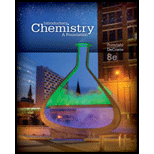
(a)
Interpretation:
Convert 75.2 kcal to joules and kilojoules.
Concept Introduction:
A conversion factor is a numerical ratio which is used to show a measurement in one unit as another unit. It is always equal to 1.
Answer to Problem 25QAP
75.2 kcal =
Explanation of Solution
The given conversion is: conversion of kilocalories to joules and kilojoules.
1 kilocalorie is equal to the 4184 joules and 4.184 kilojoules.
1 kcal = 4184 J and 1 kcal = 4.184 kJ
Thus, conversion factor is given by:
So,
(b)
Interpretation:
Convert 75.2 cal to joules and kilojoules.
Concept Introduction:
A conversion factor is a numerical ratio which is used to show a measurement in one unit as another unit. It is always equal to 1.
Answer to Problem 25QAP
75.2 cal =
Explanation of Solution
The given conversion is: conversion of calories to joules and kilojoules.
1 calorie is equal to the 4.184 joules and 0.004184 kilojoules.
1 cal = 4.184 J and 1 cal = 0.004184 kJ
Thus, conversion factor is given by:
So,
(c)
Interpretation:
Convert
Concept Introduction:
A conversion factor is a numerical ratio which is used to show a measurement in one unit as another unit. It is always equal to 1.
Answer to Problem 25QAP
Explanation of Solution
The given conversion is: conversion of calories to joules and kilojoules.
1 calorie is equal to the 4.184 joules and 0.004184 kilojoules.
1 cal = 4.184 J and 1 cal = 0.004184 kJ
Thus, conversion factor is given by:
So,
(d)
Interpretation:
Convert
Concept Introduction:
A conversion factor is a numerical ratio which is used to show a measurement in one unit as another unit. It is always equal to 1.
Answer to Problem 25QAP
Explanation of Solution
The given conversion is: conversion of kilocalories to joules and kilojoules.
1 kilocalorie is equal to the 4184 joules and 4.184 kilojoules.
1 kcal = 4184 J and 1 kcal = 4.184 kJ
Thus, conversion factor is given by:
So,
Want to see more full solutions like this?
Chapter 10 Solutions
Introductory Chemistry: A Foundation
- Please help me Please use https://app.molview.com/ to draw this. I tried, but I couldn't figure out how to do it.arrow_forwardPropose a synthesis of 1-butanamine from the following: (a) a chloroalkane of three carbons (b) a chloroalkane of four carbonsarrow_forwardSelect the stronger base from each pair of compounds. (a) H₂CNH₂ or EtzN (b) CI or NH2 NH2 (c) .Q or EtzN (d) or (e) N or (f) H or Harrow_forward
- 4. Provide a clear arrow-pushing mechanism for each of the following reactions. Do not skip proton transfers, do not combine steps, and make sure your arrows are clear enough to be interpreted without ambiguity. a. 2. 1. LDA 3. H3O+ HOarrow_forwardb. H3C CH3 H3O+ ✓ H OHarrow_forward2. Provide reagents/conditions to accomplish the following syntheses. More than one step is required in some cases. a. CH3arrow_forward
- Identify and provide an explanation that distinguishes a qualitative and quantitative chemical analysis. Provide examples.arrow_forwardIdentify and provide an explanation of the operational principles behind a Atomic Absorption Spectrometer (AAS). List the steps involved.arrow_forwardInstructions: Complete the questions in the space provided. Show all your work 1. You are trying to determine the rate law expression for a reaction that you are completing at 25°C. You measure the initial reaction rate and the starting concentrations of the reactions for 4 trials. BrO³¯ (aq) + 5Br¯ (aq) + 6H* (aq) → 3Br₂ (l) + 3H2O (l) Initial rate Trial [BrO3] [H*] [Br] (mol/L) (mol/L) | (mol/L) (mol/L.s) 1 0.10 0.10 0.10 8.0 2 0.20 0.10 0.10 16 3 0.10 0.20 0.10 16 4 0.10 0.10 0.20 32 a. Based on the above data what is the rate law expression? b. Solve for the value of k (make sure to include proper units) 2. The proposed reaction mechanism is as follows: i. ii. BrО¸¯ (aq) + H+ (aq) → HBrO3 (aq) HBrO³ (aq) + H* (aq) → H₂BrO3* (aq) iii. H₂BrO³* (aq) + Br¯ (aq) → Br₂O₂ (aq) + H2O (l) [Fast] [Medium] [Slow] iv. Br₂O₂ (aq) + 4H*(aq) + 4Br(aq) → 3Br₂ (l) + H2O (l) [Fast] Evaluate the validity of this proposed reaction. Justify your answer.arrow_forward
 Introductory Chemistry: A FoundationChemistryISBN:9781337399425Author:Steven S. Zumdahl, Donald J. DeCostePublisher:Cengage Learning
Introductory Chemistry: A FoundationChemistryISBN:9781337399425Author:Steven S. Zumdahl, Donald J. DeCostePublisher:Cengage Learning Chemistry: The Molecular ScienceChemistryISBN:9781285199047Author:John W. Moore, Conrad L. StanitskiPublisher:Cengage Learning
Chemistry: The Molecular ScienceChemistryISBN:9781285199047Author:John W. Moore, Conrad L. StanitskiPublisher:Cengage Learning World of ChemistryChemistryISBN:9780618562763Author:Steven S. ZumdahlPublisher:Houghton Mifflin College Div
World of ChemistryChemistryISBN:9780618562763Author:Steven S. ZumdahlPublisher:Houghton Mifflin College Div Chemistry In FocusChemistryISBN:9781305084476Author:Tro, Nivaldo J., Neu, Don.Publisher:Cengage Learning
Chemistry In FocusChemistryISBN:9781305084476Author:Tro, Nivaldo J., Neu, Don.Publisher:Cengage Learning Chemistry by OpenStax (2015-05-04)ChemistryISBN:9781938168390Author:Klaus Theopold, Richard H Langley, Paul Flowers, William R. Robinson, Mark BlaserPublisher:OpenStaxChemistry: Matter and ChangeChemistryISBN:9780078746376Author:Dinah Zike, Laurel Dingrando, Nicholas Hainen, Cheryl WistromPublisher:Glencoe/McGraw-Hill School Pub Co
Chemistry by OpenStax (2015-05-04)ChemistryISBN:9781938168390Author:Klaus Theopold, Richard H Langley, Paul Flowers, William R. Robinson, Mark BlaserPublisher:OpenStaxChemistry: Matter and ChangeChemistryISBN:9780078746376Author:Dinah Zike, Laurel Dingrando, Nicholas Hainen, Cheryl WistromPublisher:Glencoe/McGraw-Hill School Pub Co





